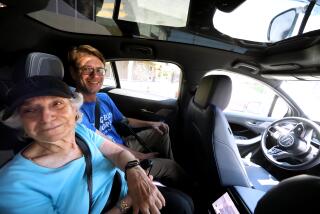Scooting into stardom
For Bruce Weinberg, riding his new Segway Human Transporter is both exciting and nerve-racking. As the first person in Los Angeles to get one, the self-declared gadget guy is excited to put the hugely hyped self-balancing scooter to good use. But he’s also nervous.
“I need to be ultra-careful, just making sure that my first impression with everybody who sees me is a positive one,” said Weinberg, who, though unaffiliated with the company, considers himself a goodwill ambassador of sorts.
Weinberg, who bought his Segway last November when the scooters first went on sale, was one of 30 people around the country who were selected, on the basis of essays they wrote, to receive the device two and a half months early. Other buyers will receive theirs in March, but Weinberg got his in late December.
Only the comatose could have missed the media frenzy surrounding the Segway since January 2001, when a journalist broke the news about a book that would track the development of “Ginger,” an unspecified new invention purported to change the way we live. What followed was a flurry of media speculation as to what that might be -- a jet pack, a mini-Hovercraft. One year later the question was answered when inventor Dean Kamen revealed Ginger’s real identity -- the Segway -- on ABC’s “Good Morning America,” promising it would “make urban environments more livable by [easing] short-distance travel.”
Those who share Kamen’s vision have been anxiously awaiting them ever since. A handful of L.A.-area companies, including Disneyland, have been using the scooters for the past few months, but Segway only made them available to individuals last November, selling them on Amazon.com for $4,950.
What that buys is a battery-operated, gyroscopically stabilized, two-wheeled scooter that imitates the movements of a human body. Riders simply adjust their center of gravity forward slightly, and they’re in motion. They think about stopping, and it’s done. Once stopped, the Segway can stand perfectly balanced, completely still. The scooter can move as fast as 12 mph and travel up to 15 miles on a single six-hour charge.
Since Weinberg got the Segway, the 34-year-old forensic psychology student has been using it to wheel all over his Hollywood neighborhood -- going to the gym, running errands, grabbing a Jamba Juice, visiting friends -- on trips he would normally take in his Toyota Prius, a hybrid car.
“It’s letting me not worry about parking spaces, not worry about a $35 parking ticket, not worry about how many quarters I have on me,” he said.
What Weinberg does have to worry about is people. As he wheeled his Segway down Melrose (it’s only allowed on sidewalks) on a recent Sunday afternoon, nearly everyone was staring, smiling, pointing. A 30-something tourist began filming him with a video camera. A teenaged skateboarder craned his neck to get a better look.
“They’ve all seen it,” said Weinberg, who wears a bike helmet on his Segway, even though the machine is so new that such safety precautions are not legally required. “They’ve just never seen one in person.”
As to getting the hang of maneuvering the machine, Weinberg says it’s a snap: “It’s a very quick learning curve because in effect the machine is intuitive.”
Like everyone else who has bought a Segway, Weinberg was trained to use it. The only difference is that Weinberg, as a winner of the “early delivery” contest, was flown for free to the company’s New Hampshire headquarters, where he learned how to navigate potholes, rocks, grass and inclines. Those who receive their machines in March will get similar training. It’s a requirement before they can take possession of their new scooters.
“We want to make sure that people who have [the Segway] become ambassadors for the product and the brand, and that means that they’re safe and have a complete understanding of it,” said Morgan Smith, Segway’s brand and marketing communications manager.
For Weinberg, that just means more stares and more finger-pointing.
“I’m not used to being in the limelight. I’m a very back-office type of person,” said Weinberg. “I’m glad it puts smiles on people’s faces. There’s nothing better in the world.”
*
Getting a move on
What: Segway Human Transporter
Cost: $4,950, available only on Amazon.com
Information: www.segway.com.






